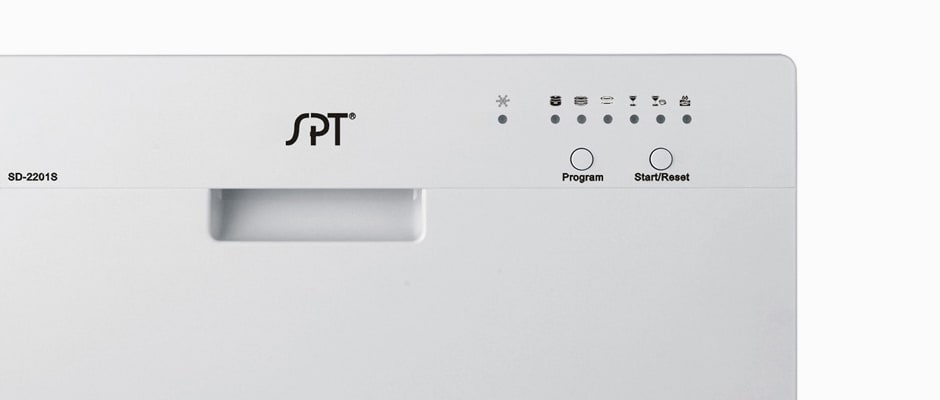Pros
-
Decent cleaning ability
-
Very affordable
-
Very portable
Cons
-
Small capacity
Introduction
We purchased a SPT (also known as Sunpentown) SD-2201W and put it through the same rigorous tests we use for full-size dishwashers. While it couldn't clean up after a dinner party for twelve, the little Sunpentown held its own, leaving dishes cleaner than many built-in units—and certainly cleaner than you could ever get them by hand. If you've got a small apartment and $250, it's time to stop hand washing your dishes.
Design & Usability
{{section_header}}{{section.name}}{{/section_header}}
Hook it up anywhere there's a faucet, provided it fits.
Sunpentown’s front door also houses the control panel. There are two hoses that join a “quick connect” mount that should attach to any faucet. One hose takes in fresh water, the other drains dirty water into the sink. Once we purchased a small 15/16 inch to 55/64 inch faucet adapter at a hardware store, we had no problem hooking up ours.
Inside, there's room for four full place settings in a single rack, a cutlery basket, a removable filter and a stainless tub. It's nearly identical to all other compact machines we've tested.
{{photo_gallery "Front Closed Photo", "Fingerprints Photo", "Controls 1 Photo", "Controls 2 Photo", "Front Open Photo", "Interior Detail Photo", "Top Rack Photo", "Top Rack Detail Photo 1", "Top Rack Detail Photo 2", "Top Rack Detail Photo 3", "Bottom Rack Photo", "Bottom Rack Detail Photo 2", "Bottom Rack Detail Photo 3", "Cutlery Basket Photo", "Cutlery Basket Detail Photo 1", "Cutlery Basket Detail Photo 2", "Cutlery Basket Detail Photo 3"}}
Features
{{section_header}}{{section.name}}{{/section_header}}
Its small size is its greatest feature.
Five cycles are on offer, ranging from heavy duty to quick. There’s also a rinse option, which might come in handy if you’re storing the dishwasher after a wash and don’t want it to smell like food residue.
As it’s devoid of most soundproofing, you’ll know when the Sunpentown SD-2201W is working. There’s a distinct hum when the pump is pushing water out of the drain, and a whooshing noise when cleaning is underway. Still, it's quieter than your significant other's complaints about the dishes piled up in the sink.
Performance
{{section_header}}{{section.name}}{{/section_header}}
As good as dishwashers three times its size
{{ amazon name="SPT Countertop Dishwasher, White", asin="B004MX8XO6", align="right" }} Cycles on this Sunpentown are pretty quick, ranging from an hour and 51 minutes for a Heavy Duty cycle to just 49 minutes for the “Speed” cycle. The Normal cycle takes an hour and 15 minutes.
After the Normal cycle, dishes emerged relatively clean. The only noticeable problem the Sunpentown had was reaching stained dishes at the back corners of the rack. The Speed cycle did almost as well, in less time. On Heavy Duty, messy lasagna and dessert pans emerged entirely clean, though some cheese remained. That’s nothing a little pre-washing wouldn’t cure, though.
The Sunpentown SD-2201W is an Energy Star rated appliance, and lived up to its classification. We calculated that the total yearly cost of running the Sunpentown SD-2201W would be $17.49, and individual washes would run between six and eleven cents each.
Conclusion
{{section_header}}{{section.name}}{{/section_header}}
Big cleaning power with a little footprint
If you’ve got limited space and can’t redesign your kitchen to install a dishwasher, the Sunpentown SD-2201W is an ideal choice. It’s small, energy efficient and actually gets your dishes clean. If you can spare $250, say goodbye to dishpan hands, and get one of these in your kitchen today.
Science Introduction
{{section_header}}{{section.name}}{{/section_header}}
Dishes emerging from the Sunpentown SD-2201W were as clean as they’d be coming out of a full-size model. Just make sure not to load the very back corners of the rack, as those items sometimes don’t get a full cleaning.
Wash Performance
{{section_header}}{{section.name}}{{/section_header}}
Does alright for a compact
Loaded correctly, the Sunpentown SD-2201W does a good job getting dishes clean. We found that the dirtiest dishes should be placed toward the center of the rack with their filth facing forward. On every cycle, a milk glass at the back corner of the rack remained just as gross as it was when we put it in, a sign that it didn’t get washed. Therefore we’d advise against placing anything there, because it just won’t get cleaned.
Remember that for the purposes of our tests, we apply a standardized amount of filth to each dish that’s greater than you’d ever put in a dishwasher. If you prewash or even just scrape your dishes, chances are yours will end up cleaner than any dish in our test loads.
The quick cycle—labeled “Speed” on this unit—did well enough for lightly soiled dishes. On our test load, it left behind more meat and oats than the other cycles, but it did pretty well on everything else. After the normal cycle, dishes emerged relatively clean. Because we couldn’t fit our burnt lasagna, baked on cheese and hardened dessert pans in with other dishes, we modified our Heavy Duty test a little for a compact dishwasher and washed only pots, pans and serving dishes. It got off everything but cheese, which is tough to wash off even in the best dishwashers.
{{photo_gallery "Science Section 1 Images"}}
Efficiency
{{section_header}}{{section.name}}{{/section_header}}
Much more efficient than hand-washing
The Sunpentown SD-2201W was more efficient than most other dishwashers we’ve tested, though it didn’t get water as warm as more feature-filled units.
It used between 0.25 and 0.5 kWh of electricity per wash. Much of that savings comes from using hot water from the tap, which means the washer itself doesn’t have to heat water very much internally. That does result in lower overall water temperatures, however.
The Sunpentown SD-2201W used between 2.42 gallons of water for a quick wash cycle to 4.16 gallons for a heavy duty wash cycle. It’s almost certain you’d use many times that amount of water if you were hand washing.
{{photo_gallery "Science Section 2 Images"}}
Meet the tester
Keith was the Editor in Chief of Reviewed's appliance and automotive sites. His work has appeared in publications such as Wired, Car & Driver, and CityLab.
Checking our work.
Our team is here to help you buy the best stuff and love what you own. Our writers, editors, and experts obsess over the products we cover to make sure you're confident and satisfied. Have a different opinion about something we recommend? Email us and we'll compare notes.
Shoot us an email


